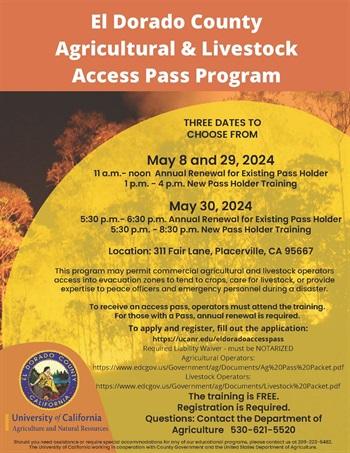
|
El Dorado and Alpine Counties
Department of Agriculture
Weights and Measures
|

|

Our Mission
To protect, enhance, and promote the preservation of agriculture and the environment, sustain public health, safety, and the welfare of all citizens, all the while providing consumer and marketplace protection through the fair and equitable enforcement of laws and regulations.
Overview
Our staff is dedicated to assisting the residents of El Dorado County through our various programs and services, including, but not limited to: pesticide registration and regulation, nursery inspections and compliance, organic production, pest detection, weed abatement, crop statistics, wildlife services, land use information, and consumer and business protection through our weights and measures program.
From this site you will be able to find links to the extensive collection of programs performed by our department, upcoming events, and regional items of interest. Scroll down for announcements and press releases.

To contact a farm advisor or access any other advisory or research needs, visit the University of California Cooperative Extension, Central Sierra, located across the hall from our Department, or visit the University of California Cooperative Extension, Central Sierra website.
Announcements

Ag Pass Program
The Ag Pass Training Classes(PDF, 6MB) will be held at the Department of Agriculture. At the dates below and on the flyer. Registration & liability waiver required. Links below.
- May 8th & 29th, 2024
11am-12pm annual renewal for existing pass holders
1pm-4pm for new pass holders
Annual Pesticide Permit, OPID and Business Registration Renewals
We will start offering 2024 permit and OPID renewals on December 1st, 2023. Please call (530) 621-5520 to make an appointment. No walk-ins accepted.
Pest control businesses and farm labor contractor registrations are now being accepted for 2024. Forms and fees for each type of registration are available on our Forms page. Payment is accepted by cash or check only.
Livestock Related
Want to learn more about cattle health? Sign up for educational webinars from the University of California.
Crop Report & Wine Grape Survey
The 2022 Crop Report(PDF, 23MB) is now available.
The 2022 Wine Grape Survey Report(PDF, 170KB) is now available.
Ranch Marketing & Winery Ordinance
Compost Program - El Dorado Disposal
El Dorado Disposal has announced a Pilot Compost Program for agricultural and community use per CA SB-1383.
Other Announcements
California Department of Food and Agriculture's Drought Resources Webpage
Regarding the El Dorado Irrigation District (EID) Small Farm Irrigation Rate